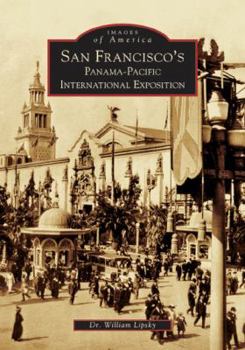San Francisco's Panama-Pacific International Exposition
(Part of the Images of America: San Francisco Series, Images of America: California Series, and Images of America: San Francisco Neighbohoods Series)
Select Format
Select Condition 
Book Overview
The 1915 Panama-Pacific International Exhibition celebrated the opening of the Panama Canal, the rebirth of San Francisco after the disastrous 1906 earthquake, and the world community in general. It was a festive time and one that transformed the swampy San Francisco waterfront into elaborate grounds for sculptures, playgrounds, fountains, and national pavilions. Some say it was the most successful world's fair ever held, bringing together disparate cultures as no other event before or since. Lasting 10 months and covering 635 acres over what is now the city's Marina District, the fair remains in evidence today at the famed Palace of Fine Arts, the only extant structure and a popular and much-photographed local landmark.
Format:Paperback
Language:English
ISBN:0738530093
ISBN13:9780738530093
Release Date:July 2005
Publisher:Arcadia Publishing (SC)
Length:128 Pages
Weight:0.70 lbs.
Dimensions:0.3" x 6.6" x 9.2"
Customer Reviews
2 ratings
Remember the P.P.I. E.
Published by Thriftbooks.com User , 19 years ago
Today international expositions like the 1964 New York world's fair, the 1939 Treasure Island fair, of even the PPIE of 1915 are no longer popular. The fairs used to be places where people could visit to see the latest in technology, visit people from foreign lands, and see and do all sorts of wondeful things. With the advent of mass media and communication, and people staying home to entertain themselves, fairs fell from fashion. Its been bandied about for years that San Francisco might put on another world's fair, but it will probably never happen. So its wonderful to look back at what most people think was the most beautful fair in San Francisco history. Started to commemorate the completion of the Panama Canal, it was also to show San Francisco had built itself back up from the destruction of the 1906 earthquake and fire. The fairgrounds were built with lavish temporary buildings extending from the Presidio, along the waterfron, up to Van Ness avenue, taking up 635 acres. Opening in February, 1915 the fair was an amazing show. The first transcontinental call was made with Alexander Graham Bell. President Roosevelt visited, and did the Liberty Bell, brought out from Pholadelphia. John Phillip Sousa and his band played, and he even wrote a piece for the fair. Camille Saint-Saens was also present, concerts being given in the Festival Hall. The Tower of Jewels loomed over the fair, at night with colored lights playing off thousands of cut crystal "gems" inside the tower. The Zone, was the amusement park area of the fair. Sadly not quite a full year later the fair ended, and was torn down, making way for new housing. This book, like many in the Arcadia series has many excellnt period photos and graphics, and also has a useful historic overview, so the reader can grasp the context of the story. I have a number of these books in my office at work. My co-workers love to look at books like this one in their spare time, to remind themselves that San Francisco has an interesting and wonderful past, rich with images and stories. This can be quite a welcome relief in these days of blaring media, political correctness and a very short collective memory.
The item of choice if you wish to recreate the 1915 celebration of the opening of the Panama Canal i
Published by Thriftbooks.com User , 19 years ago
Dr. William Lipsky's San Francisco's Panama-Pacific International Exposition is the item of choice if you wish to recreate the 1915 celebration of the opening of the Panama Canal in San Francisco. San Francisco historian Lipsky has written several others on the city: this gorgeous gathering of Pan-Pacific photos and memorabilia captures the relics and reminders of the great event which lasted 10 months and covered nearly the entire Marina District. Again, there's nothing quite like this available - packed with vintage photos and history.





